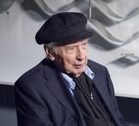Mendoza (Argentina), 1928
By Francisco Alambert
Son of a railway worker, Julio Le Parc entered the School of Fine Arts of Buenos Aires at the age of fifteen, leaving it in 1947 and returning in 1955, graduating from the Higher School. With a restless and errant life, he was a tanner apprentice, metalworker, theater doorman, and actor. From an early age, he became interested in the Concrete Art-Invention movement and the spatialism of Lucio Fontana. A Marxist, he also participated in the student movement, where he met his wife Martha, also an artist, and even served as president of the Center of Fine Arts Students. In 1957, he participated in the IV São Paulo Biennial.
In 1958, he received a scholarship from the French government and settled in Paris, where he worked for a while with Vasarely. There, he interacted with Argentine and European artists who, in 1960, founded the Groupe de Recherche d’Art Visuel (GRAV) with him, a movement linked to engaged and collective art, which questioned themes such as authorship and creativity. In 1963, the group held several demonstrations titled L’Instabilité.
Also close to the Nueva Tendencia group, Le Parc developed experimental art based on the use of light devices in which the viewer has an active role (as in the work Formas en contorsión, from 1966). In 1963, he was awarded at the Paris Biennale and, a year later, won the Di Tella International Prize in Buenos Aires. In 1966, he won the Grand Prize for Painting at the Venice Biennale and exhibited at the Howard Wise Gallery in New York and at the Galerie Denise René in Paris. The following year, he participated in the IX São Paulo Biennial, the Luz e Movimento exhibition at the Museum of Modern Art in Paris, and received the Knight of the Arts Order from France.
An anti-Peronist in Argentina, after participating in the student protests in Paris in May 1968, he was expelled from France, which led to a movement of intellectuals and artists who demanded his return. The following year, he participated in the boycott of the X São Paulo Biennial, in protest against the Brazilian military dictatorship. In 1969, he resumed painting on canvas, working with a strict range of fourteen colors. In 1972, his first retrospective took place in Düsseldorf, Germany.
From 1974 onwards, the artist developed a series of pictorial works on surfaces that, including various research themes, were collectively called Modulações. In 1978, the BBC in London produced a documentary about his life and work. In 1987, he received the I Prize of the Cuenca Biennial (Ecuador) and a year later began his research on a theme he called Alchemy.
Between 1993 and 2004, the artist exhibited at the Museo de Arte Contemporáneo Latinoamericano in La Plata, Argentina, at the Centre Pompidou in Paris, France, and at the Museum of Modern Art (MoMA) in New York, United States. In 1999, the II Mercosur Visual Arts Biennial (Porto Alegre, Brazil) organized a major retrospective of his work from the 1950s to the 1990s. In 2001, he held a major exhibition at the Pinacoteca do Estado in São Paulo. Between 2006 and 2012, his exhibition Le Parc Lumière toured various countries in Latin America. In 2012, he participated in the 11th edition of Nuit Blanche in Paris, with a light intervention on the Obelisk at Place de la Concorde. Some of his works were exhibited in the show Dínamo – A Century of Light and Movement in Art 1913-2013 at the Grand Palais in the French capital. In 2014, Casa Daros in Rio de Janeiro hosted the exhibition Le Parc Lumière – Kinetic Works by Julio Le Parc.




